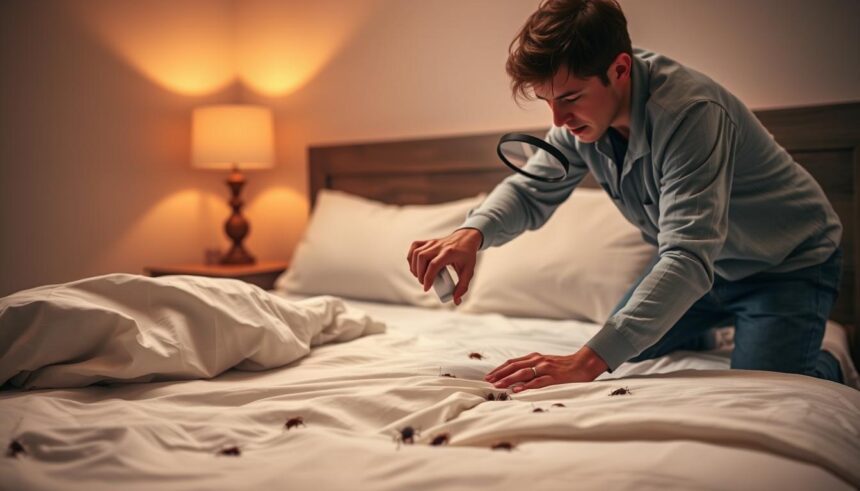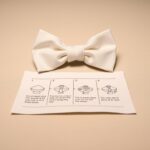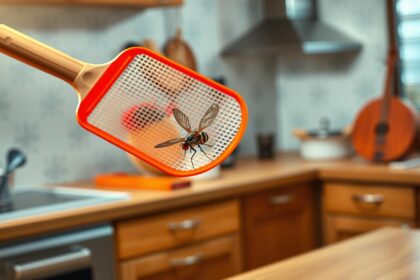You’re taking the first step towards a peaceful night’s sleep by learning how to inspect for those unwanted pests. Bed bugs can be a nuisance, but early detection is key to preventing a full-blown infestation.
By inspecting your sleeping area thoroughly, you can identify signs of bed bugs and take necessary actions to eliminate them. This guide will walk you through a simple, step-by-step process to detect bed bugs and empower you to tackle the problem confidently.
Key Takeaways
- Inspect your sleeping area thoroughly for signs of bed bugs.
- Identify common hiding spots where bed bugs are likely to be found.
- Take immediate action if you suspect a bed bug infestation.
- Use a step-by-step guide to detect bed bugs effectively.
- Stay vigilant and proactive in preventing bed bug infestations.
Understanding Bed Bugs: The Basics
Knowing about bed bugs is the first step to spotting and dealing with them. To find bed bugs, you must understand what they are and why they’re a problem.
What Are Bed Bugs?
Bed bugs are small, flat insects that drink human blood. They are known for hiding in tiny spots, making them hard to find. Adult bed bugs are 4-5 millimeters long, oval, and reddish-brown. They look different from other bugs because of their flat shape and how they eat.
Why Bed Bugs Are Problematic
Bed bugs are more than a bother; they can really upset you. Their bites can cause allergic reactions, from mild to severe. Also, knowing you have bed bugs can mess with your sleep and mood.
When checking for bed bugs, look for tiny blood spots or dark fecal spots on bedding and mattresses. Spotting these signs early is key to managing the problem.
Learning about bed bugs helps you spot signs of bed bugs and prevent or fix an infestation. This knowledge lets you keep your space free from bed bugs.
Signs of a Bed Bug Infestation
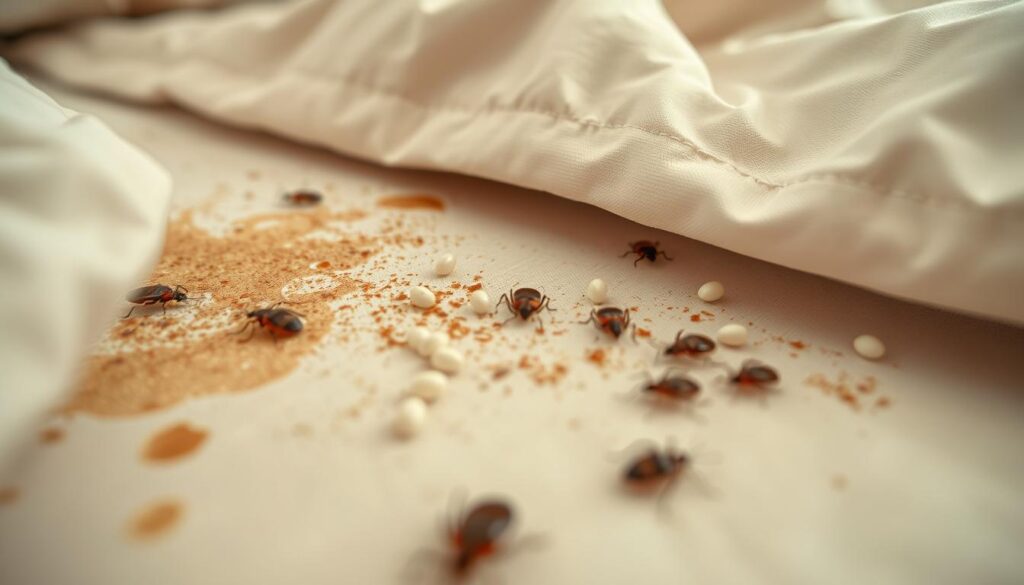
Spotting a bed bug infestation can be tricky. But knowing the signs helps you act fast. Bed bugs are hard to find, but being alert can save the day.
Physical Evidence to Look For
Looking for physical signs is a direct way to confirm bed bugs. Here’s what to search for:
- Live bed bugs: Adult bed bugs are about 4-5 mm long, oval, and flat. They are reddish-brown in color.
- Eggs and eggshells: Bed bug eggs are tiny, white, and about 1 mm long.
- Shed skins: As bed bugs grow, they shed their skins, which can be found near areas where they hide.
- Dark spots or bloodstains: Bed bugs can leave behind dark spots or bloodstains on sheets, mattresses, and walls.
Unexplained Bites and Symptoms
Unexplained bites and skin symptoms can hint at bed bugs. Look out for:
- Red, itchy welts: Bed bug bites can cause red, itchy welts on the skin.
- Swollen areas: In some cases, bed bug bites can lead to swollen areas around the bite.
Not everyone reacts the same to bed bug bites. Some might not show any signs at all.
Biological Indicators: Egg Cases and Skin
Biological signs like egg cases and shed skins are key indicators. Look for them in places where bed bugs hide, such as:
| Indicator | Description | Common Locations |
|---|---|---|
| Egg Cases | Tiny, white, about 1 mm long | Mattress seams, behind wallpaper |
| Shed Skins | Transparent, empty skins | Near beds, in furniture cracks |
“The presence of egg cases and shed skins is a strong indicator of a bed bug infestation. These signs should not be ignored.”
Knowing these signs and acting quickly can help manage a bed bug problem.
Inspecting Your Sleeping Area
Checking your sleeping area is key to spotting bed bug symptoms early. Bed bugs usually live in your bed and around it. So, it’s important to look closely.
How to Check Your Mattress and Box Spring
Begin by looking at your mattress and box spring. Take off all bedding and check every part of the mattress. Look closely at seams and edges where bed bugs like to hide.
Use a flashlight to light up dark spots. A credit card or similar tool can help you get into tight spots.
Look for tiny, red-brown spots or bloodstains. If you see any, figure out if they’re bed bug symptoms or not.
Looking at Bed Frames and Headboards
Then, check the bed frame and headboard. Bed bugs hide in small cracks and crevices. So, look at these areas carefully.
Search for signs of bed bugs like live bugs, eggs, or shed skins. Focus on the joints and underside of the bed frame.
“Bed bugs are notorious for their ability to hide in tiny crevices, making thorough inspections critical for detection.”
Inspecting Bedding and Linens
Lastly, check your bedding and linens. Wash and dry everything on high heat to kill bed bugs. Then, look at your linens, blankets, and comforters for signs of bed bugs.
Check for tiny bloodstains or dark spots. These could mean bed bug symptoms.
By doing these steps, you can check your sleeping area well. This helps find bed bug infestations early.
Performing a Room-Wide Inspection
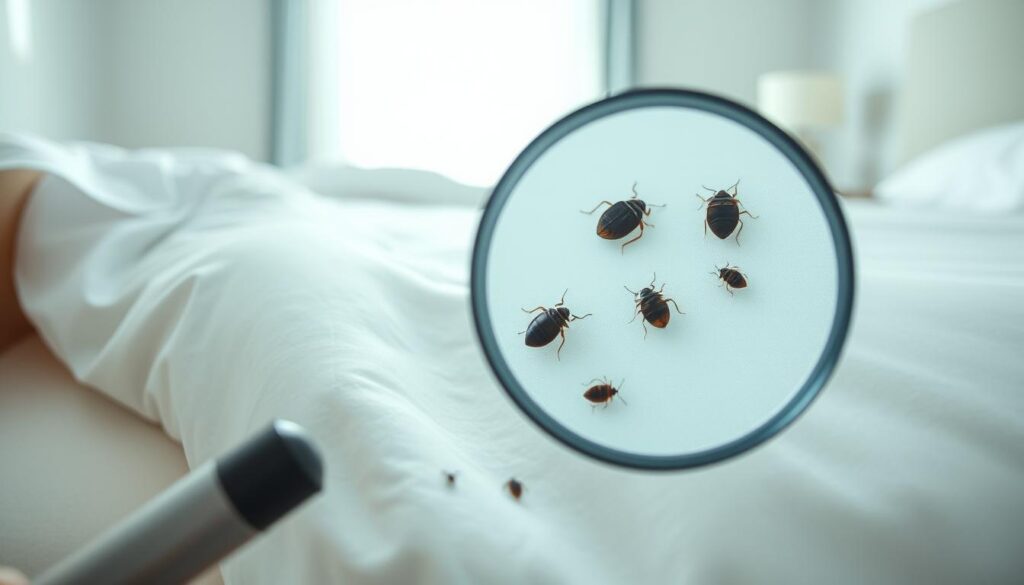
To find bed bugs, you must check the whole room, not just the bed. Bed bugs can hide in many places. So, it’s important to inspect everything carefully.
Areas Beyond the Bed: Nightstands and Dressers
First, look at nightstands and dressers. These spots are where bed bugs often hide. Search drawers, surfaces, and behind furniture for bed bug evidence like live bugs, eggs, or dark spots.
- Check drawers and remove any clutter or liners that could hide bed bugs.
- Inspect the tops and sides of furniture for any signs of bed bugs.
- Look behind furniture and check for any bed bugs hiding in cracks or crevices.
Examining Carpets, Rugs, and Upholstered Furniture
Bed bugs can also hide in carpets, rugs, and upholstered furniture. Look at these areas closely, focusing on seams and cluttered spots.
Checking Walls, Baseboards, and Electrical Outlets
Bed bugs can hide in walls, baseboards, and electrical outlets. Look for tiny bugs or eggs in these spots.
| Area to Inspect | Signs to Look For |
|---|---|
| Walls and Baseboards | Live bugs, eggs, or dark spots |
| Electrical Outlets | Bed bugs hiding in outlet crevices |
| Furniture and Carpets | Signs of bed bugs in seams and crevices |
By following these steps and checking the whole room, you can find bed bugs. This way, you’ll know how bad the problem is. You’ll be able to take steps to get rid of them.
Essential Tools for Bed Bug Detection
To find bed bugs, you need some key tools. The right gear helps spot these pests early. This lets you act fast.
Using Flashlights for Better Visibility
A flashlight is super useful for finding bed bugs. It shines light in dark spots where bed bugs hide. Use a bright LED flashlight to check cracks, crevices, and under mattresses.
Tip: Pick a flashlight with a red light option. It’s better for spotting bed bugs because they don’t get scared by red light.
Sticky Traps: A Useful Tool
Sticky traps are great for catching bed bugs. They trap bugs that crawl, proving you have an infestation. Put sticky traps in places you think bed bugs might be, like under the bed or near the bed frame.
Heat and Freeze Treatments
Heat and freeze treatments are mainly for getting rid of bed bugs. But knowing about them helps in finding where bed bugs might be. These methods use extreme temperatures to kill bed bugs.
Here’s a comparison of the tools discussed:
| Tool | Purpose | Effectiveness |
|---|---|---|
| Flashlight | Illuminates dark areas | High |
| Sticky Traps | Captures crawling bed bugs | Medium to High |
| Heat/Freeze Treatments | Kills bed bugs using extreme temperatures | High |
Using these tools helps you inspect for bed bugs better. You can then take steps to deal with any infestation.
How to Identify Bed Bugs From Other Pests
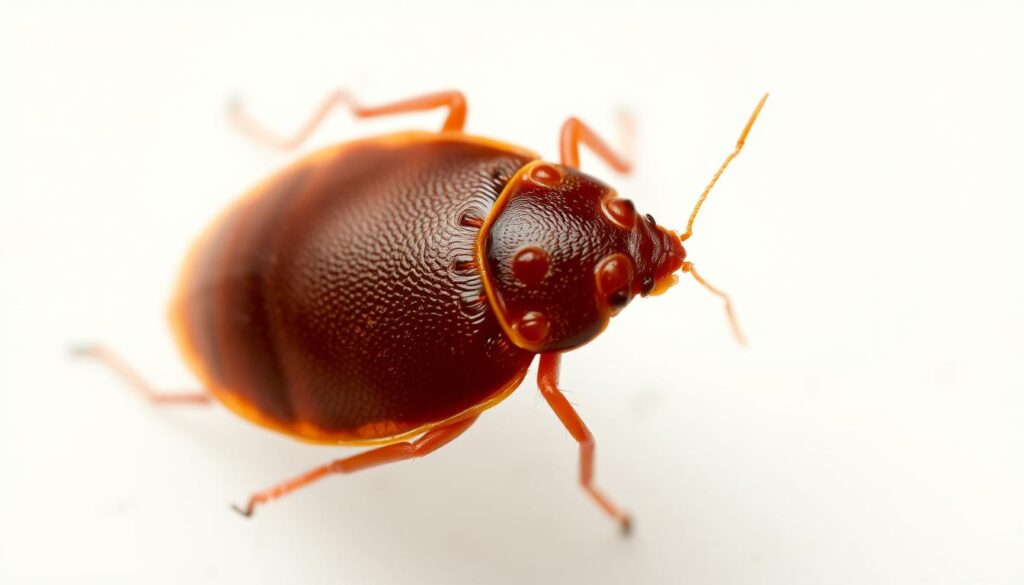
Bed bugs can look like other insects, making them hard to spot. Knowing how to tell them apart is key to getting rid of them.
Differentiating Bed Bugs from Fleas and Ticks
Fleas and ticks are pests that can be mistaken for bed bugs. But, they are different. Bed bugs are flat, oval-shaped, and about 4-5 mm long. Fleas are smaller and rounder, and ticks are bigger and rounder too.
Here’s how to tell them apart:
- Body shape and size
- Color: Bed bugs are reddish-brown
- Legs: Bed bugs have six legs
| Pest | Body Shape | Size | Color |
|---|---|---|---|
| Bed Bugs | Flat, Oval | 4-5 mm | Reddish-Brown |
| Fleas | Small, Rounded | 1-3 mm | Dark Brown to Black |
| Ticks | Rounded | Variable, often larger than bed bugs | Variable, often brown or gray |
Common Misidentifications with Other Insects
Bed bugs are often mistaken for carpet beetles or book lice. Carpet beetles are rounder and have different colors. Book lice are tiny and like damp places.
To really know if it’s a bed bug, look closely and think about where you found it. Bed bugs are usually near where people sleep and are most active at night.
Preventing Bed Bug Infestations
To lower the chance of bed bugs, take steps ahead of time. Bed bugs can sneak into your home on luggage, clothes, and used furniture. So, staying alert is essential.
Best Practices for Homeowners
Homeowners can prevent bed bugs by following some steps. First, check your home often, after guests or buying second-hand items. Seal any cracks and crevices around windows, doors, and baseboards to keep bed bugs out.
- Use mattress encasements to cover your mattress and box spring, making it harder for bed bugs to infest these areas.
- Keep your home clean and clutter-free, reducing the number of places bed bugs can hide.
- Wash and dry bedding on high heat regularly to kill any bed bugs that might be present.
Tips When Traveling and Staying in Hotels
Traveling raises your risk of bed bugs, as they can hide in your luggage. Always check your hotel room well when you arrive. Look for signs like small, red-brown spots or blood stains on the mattress, box spring, and headboard.
- Keep your luggage off the floor and away from walls to reduce the chance of bed bugs crawling into it.
- Upon returning home, immediately wash and dry your clothing on high heat.
- Inspect your luggage carefully before bringing it into your home.
By being proactive and taking these precautions, you can greatly lower your risk of bringing bed bugs home.
Steps to Take if You Find Bed Bugs
If you find bed bugs, it’s important to act fast. Bed bugs can cause discomfort and stress. Knowing how to handle them is key to solving the problem.
Immediate Actions to Contain the Infestation
When you see bed bugs, take action right away to stop them from spreading. First, isolate the area to keep bed bugs from moving to other parts of your home. Here’s how:
- Put all bedding, clothes, and items that might be infested in plastic bags.
- Vacuum the area well, focusing on the bed and furniture. Use a vacuum with a hose to reach tight spots.
- Wash and dry clothes and bedding in hot water to kill bed bugs and their eggs.
When to Call a Professional Exterminator
Even with initial steps, professional help is often needed to get rid of bed bugs for good. Call a professional exterminator if:
- The infestation is big or very bad.
- DIY methods haven’t worked.
- Bed bugs are in many rooms or areas.
A professional exterminator has the tools, knowledge, and experience to get rid of bed bugs.
Follow-Up Actions to Ensure Full Removal
After treatments, whether you did it yourself or got help, keep up with follow-up actions to make sure bed bugs are gone. This means:
- Keep watching the area for bed bugs.
- Do treatments again if needed, as the exterminator suggests or if the infestation is bad.
- Keep your home clean and clutter-free to prevent bed bugs from coming back.
By following these steps, you can make sure bed bugs are gone for good. This will bring back your comfort and peace of mind.
Bed Bug Myths: Debunking Common Misconceptions
There’s a lot of wrong information about bed bugs. It’s time to clear up the confusion. Knowing the truth helps you fight these pests better.
Common Beliefs About Bed Bugs
Many think bed bugs mean a dirty home. But, they can infest clean homes too. Another myth is that bed bugs only come out at night. But, they can hide in daytime too, in small spaces.
Common Myths vs. Reality
| Myth | Reality |
|---|---|
| Bed bugs are attracted to dirt and filth. | Bed bugs are attracted to human blood, regardless of cleanliness. |
| Bed bugs are only active at night. | While most active at night, bed bugs can be present during the day. |
| Bed bugs can be eliminated by washing and drying bedding. | Washing and drying can help, but professional treatment is often necessary. |
The Truth About Cleanliness and Bed Bugs
Cleanliness doesn’t stop bed bugs. They seek out human blood, not dirt. They can sneak into homes on used items or people’s clothes. To fight bed bugs, remember they can be anywhere, clean or dirty.
By clearing up these myths, you’re ready to tackle bed bug problems. It’s not about being clean or dirty. It’s about being alert and acting fast when you see signs of bed bugs.
Resources for Additional Help
Dealing with bed bugs can feel overwhelming. But, you don’t have to face it alone. There are many resources to help you identify and check for bed bugs. These resources can provide the support you need to tackle the problem.
Reliable Information Sources
For accurate and trustworthy information, turn to the Centers for Disease Control and Prevention (CDC) and the Environmental Protection Agency (EPA). They offer guides on identifying bed bugs and effective treatments. You can also talk to local pest control experts who know how to handle bed bugs.
Community and Government Resources
Many communities offer help for bed bug problems. Contact your local health department or housing authority for advice. They can guide you on how to check for bed bugs and prevent them from coming back. Some places even offer free or low-cost items like mattress encasements and bed bug-proof bags. Using these resources can help you manage the bed bug issue effectively.


